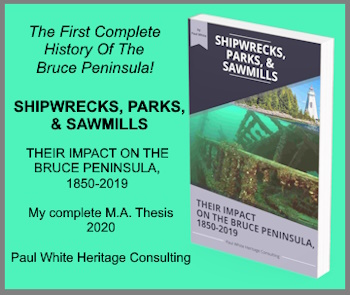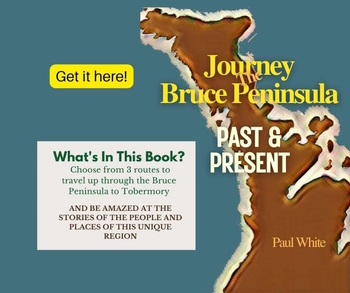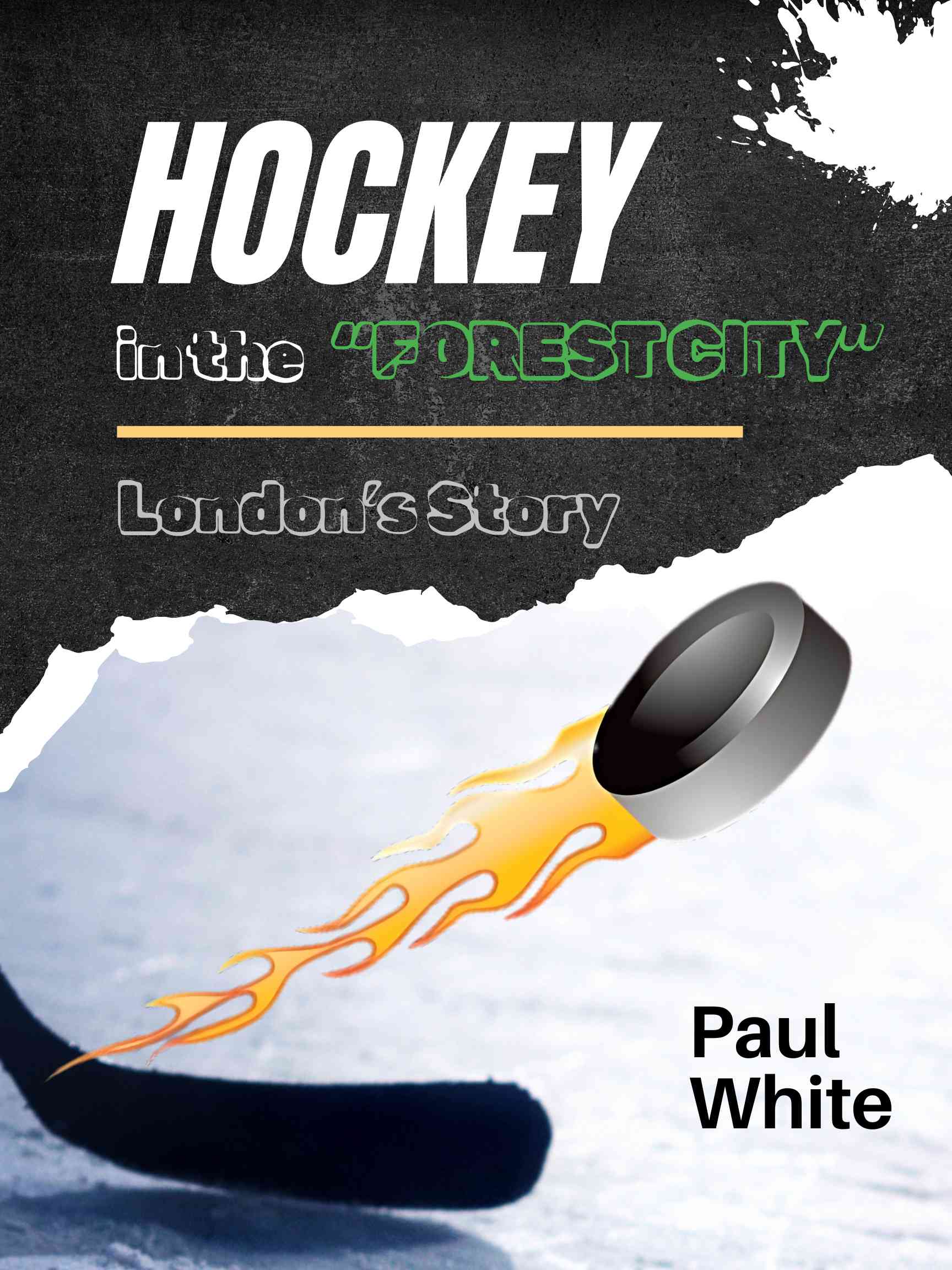Clearing Trees: a Daunting Task for Settlers
Clearing Trees a Daunting Task for Settlers as they worked to fulfill their obligations to claim land, but it was also a task necessary for clearing the way for roads in the newly settling areas of the colony.
This past Sunday, not only this area, but all of Ontario experienced terrible wind storms.
As we sat in the relative safety of our homes tremendous gusts of wind wreaked havoc all around. At one point there was a loud CRACK and a huge limb fell from one of the giant maple trees on our front lawn.
Later in the day news reports told of the carnage left in the wake of the storm. We were indeed lucky compared to some communities in the American mid-west.
In our area there were reports of hydro poles being snapped in half like toothpicks, fallen trees blocking roads and power outages. On Sunday afternoon as I drove into Owen Sound the roadway was strewn with branches and large trees lay on the ground. Many of them had been snapped from their trunk as if they were only match sticks.
The sight of large trees ripped from their ancient moorings made me think of this area when the first settlers arrived here, and I wondered if some of the larger fallen trees had been part of the original forests which blanketed this area in the 1840s.
Certainly, the size of some of them suggested that they had weathered many storms over the decades only to succumb to this latest blast from Mother Nature.
When the first settlers arrived in this region, they faced a daunting task. Part of the terms of the land grant required that they had received from the colonial government required the clearing of the land and the erection of a permanent residence. Journals and diaries from the era of the first settlers report of the land being densely covered by large trees.
An example of the density of the forest in this region occurred about 1842 when Ezra Brown arrived here from Montreal. A tanner by trade, Brown proposed building a tannery in the small clearing which marked the settlement of Sydenham. The other inhabitants of the community which was located in the general area of 8th Street East, where the city hall and Farmer's Market now stand, were repelled by the idea of a "smelly?' tannery in their midst.
Consequently, they forced Brown to locate his business a good distance to the north in the midst of the forest.
The remote location, out of the sight and smell of the other citizens of the community, was in the general vicinity of what would become in later years the intersection of 10th Street and 2nd Avenue East. This was a distance in today’s Owen Sound of only two city blocks!
The forests in the area were extremely dense and many early settlers often got lost when they ventured into the woods which surrounded the settlement. In order to aid travellers in finding their way to the clearing gunshots were fired to signal the location of the community.
Many of the trees that blanketed the area were of tremendous size. Alan Ross in his wonderful book Reminiscences of North Sydenham described the size of some of the trees that met the blade of the settler's axe.
Ross wrote that one tree was eight feet in diameter at the ground and seven feet in diameter at the stump. It was 90 feet in height and that a settler might find as many as three or four of these giants on one acre, along with all the other trees which covered his land.
When I returned home Sunday evening, I set about to remove the fallen limb and branches from our large maple. Stirred with the idea of emulating the early settlers I was almost pleased that it was too large to drag away. I grabbed my axe I set about to chop up the huge limb into more manageable sizes.
I chopped and chopped, but the limb refused to give up its pieces. Slowly I made headway, but aching muscles forced me to retire from my task before it was complete.
Again, and again I have attacked that stubborn limb with my axe, but still it stubbornly refuses to give in.
I was beginning to doubt my abilities as an axeman when at last I came upon the reason why it was so difficult a task. The axes used by the pioneers must have been of better quality than those available to us modern-day "lumber-jacks!"
A version of this article first appeared in my Local History column in the Owen Sound Sun Times.
More Grey County Pages
12-year-old Walks to Owen Sound in 1851 from the journal of a teenage boy's experience travelling with his brother in the untamed Upper Canadian wilderness.
1st Grey County Building in 1852 was only built after many hurdles were overcame.
Dr. Anna Henry from Markdale, was a medical trailblazer for women doctors in Canada, who helped lay the groundwork for the establishment for Women's College Hospital.
Egremont Township endured the usual growing pains of a pioneer community, but its early history records times when it was embroiled in a few contentious issues.
Euphrasia Township in the early years when spelling the name was a problem for those who called it home and those that wanted settle this new Grey County township.
Georgian Bay's 1st pioneer settler arrived on the western shoreline long before any other settler reached the area.
Grey County Heritage: A Valuable Resource which is rich and varied, as an important resource for future use for business, political, and many other purposes.
Grey County's Creation in 1852, laid the framework for organizing a county in the last wilderness in the southern region of what would become in the future the province of Ontario.
An Unlikely Hero From Grey County (Part 1) found his way from the farming community of Flesherton to missionary work in the Ottawa Valley, and beyond.
An Unlikely Hero Vs. The KKK (Part 2) Our hero from Grey County took his missionary zeal south of the border and ultimately crossed paths with the infamous KKK!
Barn Raising: A Pioneer Economic and Social Necessity as it provided settlers with an opportunity not only to build a barn, but also build a community.
"Barring Out": A Pioneer School Tradition was a custom which the settlers brought to the new world from England, or Scotland.
Ceylon Ontario: How it Got its Name: It is always interesting how a community got its name, but I doubt any place received its name from a more unique source!
Chatsworth Ontario: First Settlers took advantage of fulfilling the needs of pioneer travellers and built a thriving community in the Upper Canadian wilderness.
Clearing Trees a Daunting Task for Settlers as they worked to fulfill their obligations for their land grant.
Dornoch: or is it Smithville? Originally it was Smithville, then it became Dornoch. But, surprise it is still, in reality Smithville!
First Pioneer in Durham: Archibald Hunter established his family, and a hotel, in what would become the centre of the town of Durham.
Durham Ontario Influenced by the Saugeen River. This river provided a means to create new industries, but especially in the spring it can also pose a menace to the community.
Grey County Bylaws to the 1890s reveal a lot about the financing of local government, especially education in the early days of the region.
John Muir, the legendary naturalist, who promoted the idea of protected nature spaces, spent time in Ontario and I went to help find evidence of his stay in the Owen Sound area.
A Heroic Woman From Grey County who made great changes as a doctor in China in the 1890s and early 1900s.
Jesse James: In Grey County? An interesting question. Did the notorious gangster hide out in Proton Township? We will never know. But it is fun to speculate!
Kilsyth's Train Engine was one for the history books. It brought an evening of joy followed by disappointing news soon after.
The Knight's of Meaford have long history in that Grey County community. Their business forged by early settlers employed many locals and supported the economy.
Leith: Tom Thomson's Birthplace is part of the rich heritage of this community located on the east shore of the Georgian Bay north of Owen Sound.
The Leith Golf Course has provided many families with great memories. The history of this golf course starts, and ends, with the generosity of one family.
Agnes Macphail was a political trailblazer in a part of Ontario that one could hardly expect such radical action for the era in a rural region.
Markdale Ontario: The Beginning: originally known as Glenelg East, but the coming of the railway and the name of owner of the land for the station led to a change of identity.
Meaford's history is one of hardy and entrepreneurial pioneers carving their lives out of the wilderness of what would become Grey County.
Meaford Ontario, first called Peggy's Landing located on the shores of Georgian Bay has a rich history.
Meaford vs Purdytown. Conflict over the name of a new community was not unusual in early Grey County but electing a school trustee was the "hot button" issue in this rivalry.
Pioneer Clergyman: John Neelands was the first to minister to the first settlers' spiritual needs riding on horseback through the wilds of early Grey County.
Pioneer Doctor: Dr. James Smith, a local boy who became a doctor and served his community for his entire life was a testament to Grey County community spirit.
Pioneer Healthcare in Grey and Bruce counties was not administered by doctors, nurses, or pharmacists, no it was the responsibility of the women of the community.
Pioneer Homes in Grey County in the 1840s offered only basic amenities. Homes were basic because clearing the land to earn a living to survive were of paramount importance for those embarking on a new life.
Pioneer Ingenuity created many labour saving devices and methods and quite often helped to create a sense of community.
Pioneer Christmas: A Family Tradition as told to me by may grandparents who experienced Christmas as children in the 1880s and 1890s.
Pioneer Settlement Plans for Grey County began almost two decades before the rest of Grey County was available for settlement.
A pioneer road surveyor's impact on the local history of Grey and Bruce counties could have been dramatic, if it had not been changed by another surveyor.
Pioneer Teachers in Grey and Bruce Counties had a long and arduous task, not to mentions strict and confining job requirements for very little salary.
Plowing Match in Grey County in 1933 the first International Plowing Match held in Grey and Bruce counties and it's success led to more such events in Grey.
Settling Osprey Township: Parts of Osprey were considered too rugged to settle, but today they are prime real estate because of the great view!
Swamp College: Proton Township: this colourfully named institution of education in Grey County has provided many stories to the heritage of the region.
Sydenham Township's First Council undertook the often difficult task of creating a new municipal infrastructure.
The Impact of Snow is not what is Used to be! As snow removal equipment has improved the impact of snow on our lives has reduced significantly from previous eras.
Unique Characters: Nathaniel Herriman lived in Grey County and owned an inn to provide food and and accommodation to early travellers. Each day he performed a unique practice.
Unique Maps: Quilts Guided the Underground Railroad to enable runaway slaves to escape to Canada and freedom from the shackles that enslaved them.
The Women's Institute is a group of rural women that has made a difference to the quality of both urban and rural life in Grey County and across the country.





